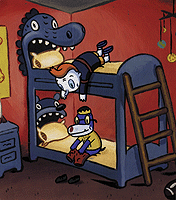|
|
ANIMATION WORLD MAGAZINE - ISSUE 5.8 - NOVEMBER 2000
The Music, The Pageantry, The Fourth Grade…by Joan Kim
Arriving on Disney’s One Saturday Morning lineup this past fall, Teacher’s Pet delivers the rich and playful animation of Gary Baseman and the experienced storytelling of Bill & Cheri Steinkellner. The series introduces viewers to its endearing cast with the flare of a Broadway musical. Central to the story are the desires of a boy, Leonard, and his best friend, his dog Spot, but Spot isn’t an ordinary dog. Spot, in fact, doesn’t even want to be a dog. He wants to be a boy. Leonard is trying to be just a regular fourth grader -- normal in the blandest way possible -- but between the antics of Spot and the fact that his mother teaches his class and periodically humiliates him by calling him "doodlebug," he’s having a tough time. His difficulties multiply when, much to his horror, he realizes that the new boy in school, Scott Leadready II, is Spot! His goal of being "normal" is further confounded when he becomes the sole human emissary to the world of fuzzy (and feathery) critters. Yes, he can talk to the animals. His attempts to avoid being the teacher’s pet are abruptly, and ironically, alleviated by the exemplary academic performance of the new kid -- his dog -- who ends up becoming the teacher’s pet. While of course comedic situations arise, the stories always end in lessons being learned and intelligent realizations made to mediate all the canine madness.
If the Dog Could Only Talk His unique visual style and attitude is not lost in the cartoon. Timothy Bjorklund who directs the series vividly translates Baseman’s artistic vision. "Tim has really sought to ensure every frame of the show -- and that’s 12 drawings per second -- looks like a Baseman painting," says Baseman.
In addition to show’s unique visual style, the Steinkellners’ writing expertise marries together a particular blend of craziness and credibility. In the first episode, "Muttamorphosis," as the title suggests, we encounter Spot deliberating over whether to continue eating doggy treats or to grab a backpack and go to school. Decidedly, Spot undergoes an inspiring transformation when he jumps into Leonard’s trousers, dons a cap and in Clark Kent fashion puts on a pair of glasses. The pearls to his outfit? The bunny backpack selected by Mrs. Helperman, predictably rejected by Leonard, of course. As writers, the Steinkellners find a perfect vehicle for exciting learning in the natural characteristics associated with the lovable canine. Cheri Steinkellner states, "We love a character who’ll drive a story and really push it forward with energy and enthusiasm. These are very dog-like qualities. All the tail-wagging and jumping up and down and slobbering. What fun to take all that puppy hyper-joy and make it about something not traditionally viewed as a joyful experience -- like the fourth grade." Truth is Stranger Than Fiction
|
||||||
|
1 |
2
|


